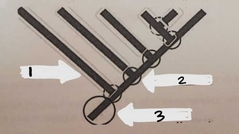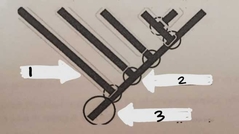![]()
![]()
![]()
Use LEFT and RIGHT arrow keys to navigate between flashcards;
Use UP and DOWN arrow keys to flip the card;
H to show hint;
A reads text to speech;
101 Cards in this Set
- Front
- Back
- 3rd side (hint)
|
SIZE WATER REQUIREMENT ABILITY TO MANUFACTURE FOOD HABITAT LIFESPAN BODY APPEARANCE |
Through natural selection, plant phyla can be classified as... 1-6 |
|
|
|
SIZE |
This says that plants can be microscopic or macroscopic |
|
|
|
XEROPHYTES |
Type of plants that have minimal water requirement |
|
|
|
MESOPHYTES |
Plants that can survive on moderate amount of water |
|
|
|
HYDROPHYTES |
Plants that need continuous supply of water |
|
|
|
AUTOTROPHS |
Plants that make their own food |
|
|
|
HETEROTROPHS |
Plants that depend on the environment obtain food |
|
|
|
Aquatic, Terrestrial, and Aerial |
3 types of plant habitats |
|
|
|
Aquatic |
Plants that live in/on water |
|
|
|
TERRESTRIAL |
Plants that live on the ground |
|
|
|
AERIAL |
Plants that live hanging from walls or tall objects |
|
|
|
ANNUALS |
Plants that have one year lifespan Examples are beans, tomatoes, and peas |
|
|
|
BIENNIALS |
Plants that have a two-year life cycle Examples are carrots, and bulbs |
|
|
|
PERENNIALS |
Plants that mature every year as it grows older Examples are trees |
|
|
|
Trees, shrubs, herbs, and vines |
Name four types of body appearances of plants |
|
|
|
Vascular and Non-Vascular Plants |
According to the Linnaean Classification, plants can be classified into 2 types |
|
|
|
Non-Vascular plants |
No xylem and phloem "Amphibians of the plant world" |
|
|
|
Bryophytes |
Other name for Non-vascular plants |
|
|
|
Mosses, liverworts, and hornworts |
3 types of Bryophytes |
|
|
|
VASCULAR plants |
Have true xylem and phloem |
|
|
|
TRACHEOPHYTES |
Other name for VASCULAR plants |
|
|
|
FERNS GYMNOSPERMS ANGIOSPERMS |
3 types of vascular plants |
|
|
|
FERNS |
-Aka PTERIDOPHYTA or FILICINOPHYTA -Has sori, curled crosiers and rhizome roots |
|
|
|
SORI |
Part of a fern that have matured fronds that produce spores |
|
|
|
GYMNOSPERMS |
-AKA Cone Bearers -Have naked seeds/ not enclosed in fruits -cone is the main reproductive structure |
|
|
|
Conifers/CONIPHEROPHYTA |
Type of Gymnosperm -smaller cones |
|
|
|
Cycads/CYCADOPHYTA |
Type of Gymnosperm -larger cones |
|
|
|
GINGKOPHYTA / gingko biloba |
Type of Gymnosperm -have seeds hanging from branches |
|
|
|
ANGIOSPERMS |
Flower bearers/vessel seeds -w/ flower, fruit and cotyledon -reproduce thru seeds in flowers |
|
|
|
FRUITS |
Ripened plant ovary |
|
|
|
MONOCOT |
Type of Angiosperm -Parallel leaf veins -petals w/ multiples of 3 -scattered vascular bundles |
HAS ONE COTYLEDON |
|
|
DICOTS |
Type of Angiosperm -Net-like veins in leaves -Petals w/ multiples of 4-5 -Ringed vascular bundles |
|
|
|
PORIFERA |
Aka pore bearers ✓Simplest, most primitive ✓can be Sessile or a Filter feeder ✓asymmetrical |
Sponges |
|
|
SESSILE |
Characteristic of Porifera that describes them as non-motile, and are attached to rocks and shells |
|
|
|
Body, Spicules, and Amoebocytes |
Body structure of a PORIFERA |
|
|
|
BODY/ SPONGIN |
Porifera body structure that is composed of 2 layers of cells of collagen fibers |
|
|
|
SPICULES |
Porifera body structure that is composed of silicon-based crystals Aka Skeleton |
|
|
|
AMOEBOCYTES |
Porifera body structure that is the jelly material Aka Middle layer |
|
|
|
CNIDARIA |
"Marine stingers" ✓ aka Coelenterates ✓has 2 layers of ectoderm and endoderm ✓has nerve network
|
|
|
|
TENTACLES/STINGING CELLS/ NEMATOCYSTS |
Capsule of Cnidaria containing thin, coiled, harpoon-shaped tubules with poisonous barb at one end |
|
|
|
POLYP and MEDUSA |
2 basic forms of CNIDARIA |
|
|
|
POLYP |
Form of Cnidaria ✓cylindrical tube, w/ mouth and tentacles facing upward |
|
|
|
MEDUSA |
Form of Cnidaria ✓umbrella-shaped, with mouth and tentacles facing down |
|
|
|
True |
T/F Cnidaria has incomplete gastrovascular cavity |
|
|
|
TRUE |
T/F Excretion in Cnidaria is through diffusion via Body walls |
|
|
|
TRUE |
T/F Cnidaria have no hearts nor brains but have nerve nets |
|
|
|
MOLLUSCA |
✓Soft, unsegmented body, w/ strong muscular foot on it's ventral surface and w/ outer shell covering ✓Some have gills ✓Bilateral symmetry |
|
|
|
Radial/ Spoke-like |
Symmetry of Cnidaria |
|
|
|
RADULA |
Feeding organ of Mollusca |
|
|
|
MANTLE |
The tissue covering of Mollusca for protection |
|
|
|
ARTHROPODA |
AKA Jointed Foot ✓1 foot always has another pair ✓Segmented body ✓paired jointed appendage ✓exoskeleton is made out of chitin |
|
|
|
Head, Abdomen and Thorax |
Arthropoda's bodies are commonly divided into 3 parts... |
|
|
|
BILATERAL |
Symmetry of Arthropoda |
|
|
|
FALSE |
T/F Arthropoda does not have open circulatory systems, and complex central nervous system |
|
|
|
TRUE |
T/F Arachnids, insects, crustaceans and centipedes are examples of Arthropoda |
|
|
|
ECHINODERMATA |
AKA Spiny Marines ✓slow moving ✓spiny surface skin, has internal skeleton and calcium-rich interlocking plates |
|
|
|
RADIAL |
Echinodermata, when in MATURE form displays what kind of symmetry? |
|
|
|
BILATERAL |
Echinodermata, when in LARVAE form displays what kind of symmetry? |
|
|
|
TRUE |
T/F Echinodermata can regenerate |
|
|
|
True |
T/F Echinodermata have complete digestive system |
|
|
|
True |
T/F Echinodermata have water vascular systems, respiratory system, with simple excretory system and with nerve roots |
|
|
|
NEMATODA |
AKA "roundworms" ✓Long, smooth, cylindrical, and segmented body, tapered at both ends and covered by cuticle ✓parasitic |
|
|
|
ECTODERM, MESODERM, and ENDODERM |
Nematoda have three body layers namely... |
|
|
|
BILATERAL or ANTEROPOSTERIOR |
Symmetry for nematoda |
|
|
|
TRUE |
T/f : Nematoda have complete digestive system, & excretory system, but absent circulatory and respiratory system |
|
|
|
Pinworms and hookworms |
Examples of Nematoda |
|
|
|
ANNELIDA |
AKA Segmented worms -Reproduce via fragmentation - have CLITELLUM (reproduction support) -bilateral symmetry Ex. Earthworm, leech.. |
|
|
|
PLATYHELMINTHES |
AKA Flatworms ✓flat body, unsegmented, no cavity ✓3 layers same as NEMATODES ✓Bilateral, has definite head and tail ✓hermaphrodite |
|
|
|
CHORDATA |
AKA Vertebrates -have spinal cord -post anal tail and pharyngeal slits -Bilateral |
|
|
|
CHORDATA |
Only animal phyla that has developed organ system |
|
|
|
Amphibians, Reptiles, Mammals, Birds, Fish... |
Examples of Chordata |
|
|
|
TAXONOMY |
-Science of naming and classifying organisms -Coined by Carolus Linnaeus |
|
|
|
BINOMIAL NOMENCLATURE |
System that gives a species a 2 part scientific name -composed of Genus in capital, and species in lowercase |
|
|
|
Eubacteria Archeabacteria Eukaryote |
3 main Domains of Linnaean Classification |
|
|
|
MONERA PROTISTA FUNGI PLANTAE ANIMALIA |
5 Kingdoms accdg to Linnaean Classification |
|
|
|
KINGDOM PHYLUM CLASS ORDER FAMILY GENUS SPECIES |
Linnaean Classification ranks (Krispy Pried Chicken Over Fine Gravy Sauce) |
|
|
|
MONERA |
-Only prokaryotic kingdom -unicellular & colonial -ex. Eubacteria and Cyanobacteria |
|
|
|
PROTISTA |
-both uni and multicellular - a/sexual reproduction -have cilia and flagella -can be pathogenic Ex. Amoeba, paramecium, slime mold, euglena |
|
|
|
FUNGI |
-haploid and dikaryotic/binucleate cells -multicellular -HETEROTROPHIC mainly SAPROPHYTIC |
|
|
|
Zygomycota, Oomycota, Ascomycota, Basidiomycota, and Deuteromycota |
5 phyla of Fungi |
|
|
|
ZYGOMYCOTA |
Fungi Phyla: Bread molds |
|
|
|
ASCOMYCOTA |
Fungi Phyla: Sac Fungi |
|
|
|
OOMYCOTA |
Fungi Phyla: Water molds |
|
|
|
BASIDIOMYCOTA |
Fungi Phyla: Club Fungi |
|
|
|
DEUTEROMYCOTA |
Fungi Phyla: Fungi Inperfecti |
|
|
|
PLANTAE |
-Multicellular & eukaryotic -capable of photosynthesis, w/ tough and rigid cell walls |
|
|
|
ANIMALIA |
-Multicellular, w/o cell walls - no photosynthetic pigments -forming diploid blastula |
|
|
|
PHYLUM |
It is a rank in Linn. Classification: ✓Physical similarities among organisms in a kingdom ✓having common ancestry |
|
|
|
CLASS |
It is a rank in Linn. Classification: ✓way to further subdivide organisms in a Phylum |
|
|
|
ORDER |
It is a rank in Linn. Classification: ✓a taxonomy key is used to determine to which ___ an organism belongs. |
|
|
|
FAMILY |
It is a rank in Linn. Classification: ✓share so much in common, related to each other |
|
|
|
GENUS |
It is a rank in Linn. Classification: ✓generic name for an organism ✓ determines the first name in binomial nomenclature |
|
|
|
SPECIES |
It is a rank in Linn. Classification: ✓lowest and most strict level of classification ✓main criterion is ability to breed (interbreeding) |
|
|
|
Domain: Eukaryotic Kingdom: Animalia Phylum: Chordata Class: Mamalia Order: Primate Family: HOMOnidae Genus: Homo Species: Homo sapiens |
Linnaean Classification of humans |
|
|
|
CLADOGRAM |
✓Used in cladistics ✓AKA phylogenic tree ✓uses homologous structures to show relationship of organisms w/o regards to Linnaean ranks |
|
|
|
BRANCH
|

Number 1 Lineages of an organism -When a new trait arises that sets the organisms apart from the rest of the clade |
|
|
|
NODE |

Number 2 - Speciation is the hypothetical lasts ancestral interbreeding population of the taxon labelled at the TIP of the cladogram |
|
|
|
ROOT |

Number 3 Signifies common ancestor |
|
|
|
OUTGROUP |
Related to the root of the organism but not as closely related to the other terminal nodes |
|
|
|
SISTER GROUPS/SPECIES |
Closest relatives in each node |
|
|
|
CLADISTICS |
a system of biological taxonomy that defines taxa uniquely by shared characteristics not found in ancestral groups and uses inferred evolutionary relationships to arrange taxa in a branching hierarchy such that all members of a given taxon have the same ancestors |
|

